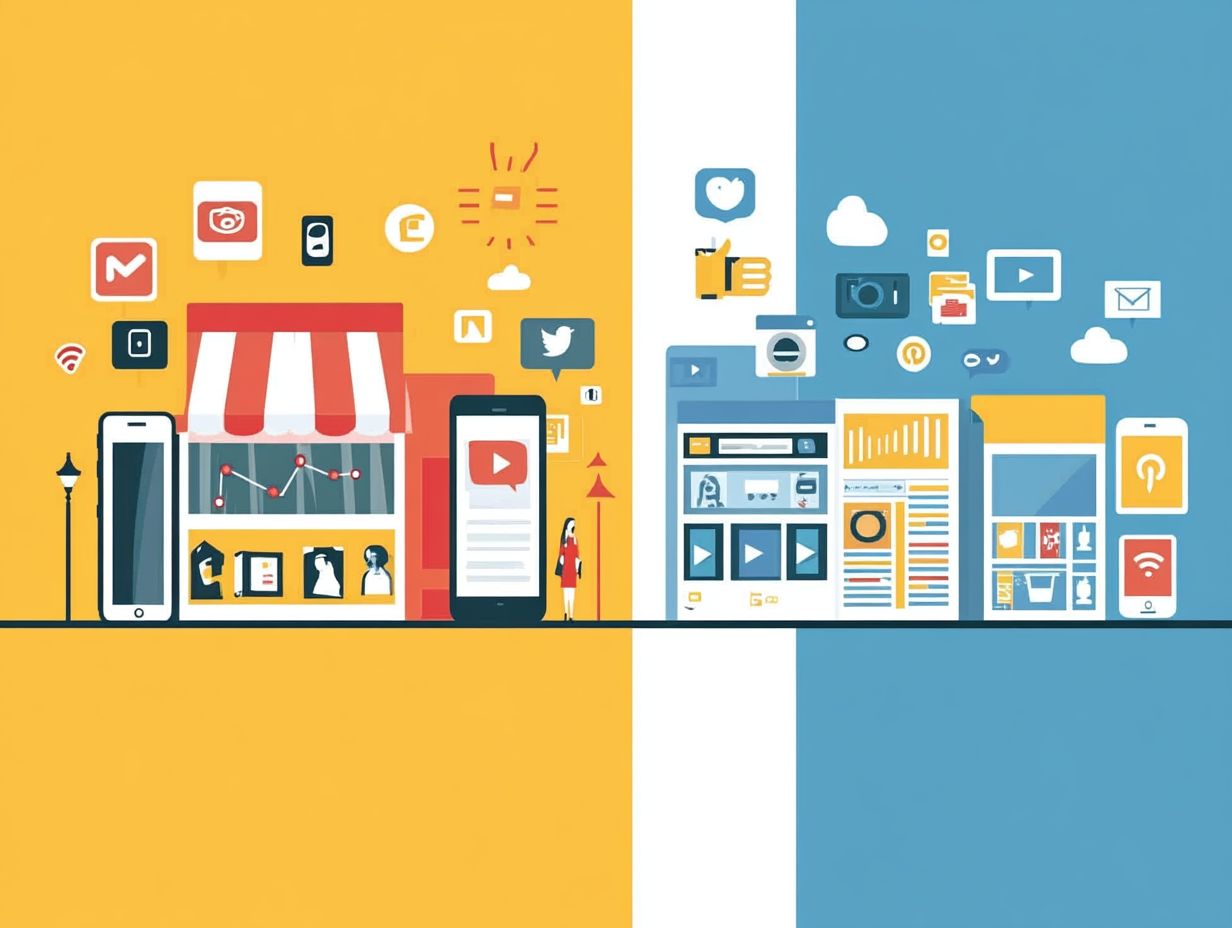Grasping the distinctions between digital marketing and traditional marketing is crucial for any organization striving for success, as it involves understanding both online advertising and offline advertising strategies.
In this article, we’ll explore the key differences in cost, audience targeting, and effectiveness metrics, while also considering how consumer behaviors and marketing trends impact these marketing methods.
We’ll delve into the benefits of digital marketing, identify which businesses gain the most from it, and emphasize the significant role of social media marketing and content marketing.
Additionally, you’ll gain insights on how to merge both strategies effectively through synergy and marketing automation, and discover successful case studies. Keep reading to find out which marketing approach aligns best with your objectives and brand positioning.
What are the key differences between digital marketing and traditional marketing?
Digital and traditional marketing differ mainly in reach, audience targeting, and engagement methods. Digital marketing strategies like SEO, PPC, social media, and email marketing provide unique opportunities to connect with consumers. In contrast, traditional marketing uses print media, television ads, radio ads, and billboards, usually offering limited ways to measure effectiveness. Understanding these differences is important for creating marketing strategies that connect with your audience.
Digital platforms allow brands to instantly reach a global audience and target specific demographics, interests, and behaviors, leading to higher engagement due to personalized messaging. Traditional marketing, meanwhile, often targets a broad audience, resulting in lower ROI as it struggles to engage consumers personally.
Digital marketing costs are more flexible, allowing budget allocation changes based on performance, whereas traditional methods often have fixed expenses that might not align with current trends.
Digital marketing offers more advanced tools for measuring advertising effectiveness, using real-time data and engagement metrics, unlike the general feedback usually gathered from traditional methods.
How does the cost of digital marketing compare to traditional marketing?
Comparing digital marketing to traditional marketing reveals notable cost differences, offering businesses flexible options for any advertising budget. Digital marketing is often more cost-effective, providing measurable results and a higher ROI thanks to targeted methods like social media marketing and email marketing.
Traditional marketing, although impactful, typically needs more ad spending for less reach and performance measurement.
Digital marketing is also more budget-friendly and allows for precise performance tracking, letting companies analyze customer engagement in real-time. This immediate feedback helps them allocate resources efficiently and optimize campaigns as they go.
On the other hand, traditional channels often lack this clarity, which can lead to overspending without certain results. As businesses explore different marketing channels, digital platforms stand out not only for their cost benefits but also for their ability to adapt strategies using real-time data, ensuring every marketing dollar is used effectively.
What metrics can you use to measure the effectiveness of digital marketing vs. traditional marketing?
Evaluating digital marketing against traditional marketing requires different metrics suited to each approach, including digital tools for data-driven marketing.
Digital platforms allow businesses to track specific behaviors like click-through rates and customer acquisition costs, providing a detailed understanding of campaign effectiveness. This real-time data helps marketers make quick, informed decisions and adjust strategies as needed.
In contrast, traditional marketing relies on broader metrics such as brand impression and sales volume, offering a general view of success that may not capture current marketing trends. While traditional methods provide long-term insights, the immediate and detailed analysis offered by digital analytics is a significant advantage for quickly optimizing marketing efforts.
How does audience targeting differ in digital marketing and traditional marketing?
Audience targeting is a key advantage of digital marketing compared to traditional methods, as it allows for precise targeting and segmentation based on behavior. Through digital platforms, we can reach specific groups with tailored content and ads, improving audience engagement and conversion rates.
In contrast, traditional marketing often relies on broader approaches through mediums like print ads or TV commercials.
This precision in digital marketing comes from extensive data on consumer behavior and preferences, enabling marketers to craft messages that resonate with targeted audiences. By analyzing metrics such as user engagement, click-through rates, and past purchase behavior, marketers can constantly adjust their strategies to make their campaigns more effective.
Traditional marketing strategies often depend on general market demographics, which can result in wasted resources and may not connect with specific audience needs, reducing overall effectiveness and return on investment (ROI).
What are the advantages of digital marketing over traditional marketing?
Digital marketing offers many advantages over traditional marketing, significantly enhancing brand awareness and customer acquisition. Strategies like content marketing, social media, and mobile marketing allow businesses to reach a wider audience with measurable results.
These methods enable real-time adjustments and are more cost-effective, maximizing ROI compared to traditional methods like print media or billboards.
Digital marketing allows precise audience targeting, creating tailored messages that resonate with various demographics. Advanced market analysis tools provide insights into consumer behavior and preferences, enabling deeper engagement through personalized experiences.
This modern approach is essential for staying relevant in a fast-changing market. The ability to track and analyze data in real time helps marketers continuously refine their strategies, improving campaign effectiveness and driving higher conversion rates through visual content and brand engagement.
What types of businesses benefit more from digital marketing compared to traditional marketing?
Certain businesses benefit more from digital marketing than traditional methods, particularly those targeting specific niches or younger audiences through demographic targeting and digital content.
For example, e-commerce platforms often succeed by using targeted social media ads and engaging content strategies that appeal to younger customers, enhancing their digital footprint.
Service-based businesses like fitness coaching or beauty salons gain from SEO-focused websites and online booking systems that improve the customer experience and customer journey.
Businesses focused on customer engagement, such as tech startups or subscription services, can use email marketing and influencer partnerships to attract new customers and retain current ones through effective retention strategies.
On the other hand, larger corporations seeking broad brand awareness may find traditional marketing methods more effective, as they are less reliant on data-driven marketing insights for their strategy.
How do consumer behaviors influence the effectiveness of digital vs. traditional marketing?
Consumer behaviors significantly impact the success of digital versus traditional marketing strategies. As more consumers use online platforms for purchasing decisions, understanding user engagement and preferences helps businesses adjust their marketing tactics to enhance lead generation and brand loyalty.
However, traditional marketing can still appeal to some audiences, particularly those familiar with older formats, including traditional media like newspapers and radio.
Marketers must stay flexible, adapting their methods to attract a tech-savvy audience that values convenience and quick access to information. As customers engage more with social media and mobile apps, using data analytics has become essential for creating personalized campaigns and improving marketing performance.
It’s important not to completely abandon traditional channels, as some groups still value local newspapers, radio ads, and direct mail for their tangible experiences, which digital methods may lack. Balancing these approaches can improve marketing effectiveness, ensuring that both modern digital trends and traditional methods meet consumer expectations.
What is the role of social media in digital marketing compared to traditional marketing channels?
Social media is crucial in digital marketing, providing unique opportunities for audience engagement and content distribution that traditional marketing cannot match, enhancing brand messaging.
Using these platforms, businesses can create stories that connect with their audience, improving the effectiveness of their content marketing strategies.
Engaging customers with interactive posts, polls, and live sessions increases engagement rates and builds a community around the brand, fostering brand loyalty.
Social media also allows for real-time feedback, helping brands adjust their strategies based on customer responses and preferences. This interaction creates a deeper connection with the audience, strengthening brand identity and positioning in a competitive market through customer feedback.
How can businesses integrate both digital and traditional marketing strategies?
Combining digital and traditional marketing strategies is crucial for businesses seeking to effectively reach their target audience through a comprehensive omnichannel strategy.
By aligning these different methods, companies can streamline their marketing processes, providing a smooth experience for customers across various platforms. A unified strategy improves brand recognition and builds trust, as consumers receive consistent messages everywhere, enhancing brand awareness and brand engagement.
Using data analytics from digital campaigns can enhance traditional marketing methods, enabling more targeted print advertising or well-timed broadcasts that better connect with the target audience. This combined approach not only enhances customer experience but also increases return on investment (ROI), supporting long-term growth and brand loyalty.
What are some successful case studies demonstrating the effectiveness of digital marketing over traditional marketing methods?
Successful case studies highlight how digital marketing outperforms traditional marketing by boosting brand awareness and conversion rates. Brands using online advertising, SEO, and PPC on digital platforms for targeted ads and content often report better engagement and ROI than those relying only on print media or traditional advertising.
For example, Nike’s ‘Dream Crazy’ campaign effectively used social media marketing to reach younger audiences with messages of inclusivity and activism, leading to a 31% increase in online sales within four weeks. Similarly, Dove’s ‘Real Beauty’ campaign utilized content marketing with user-generated content and emotional storytelling to connect with consumers, generating millions in revenue and positioning the brand as a supporter of body positivity.
These examples show how strategic digital marketing utilizing diverse marketing channels can lead to measurable results and improved brand image, highlighting the shift towards a more connected and responsive marketing environment that leverages digital tools and market research.




